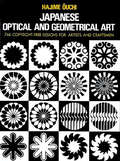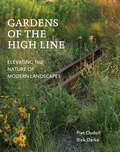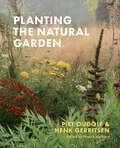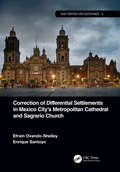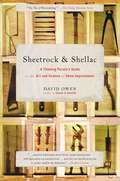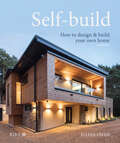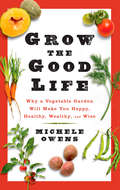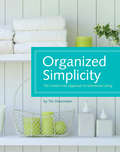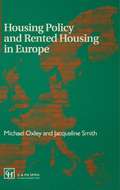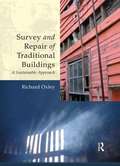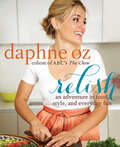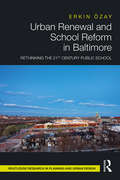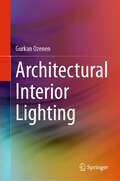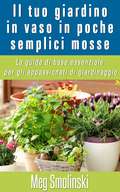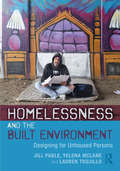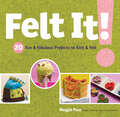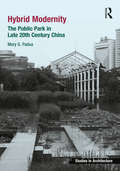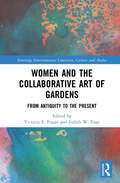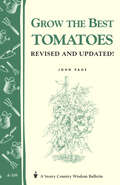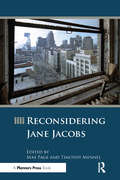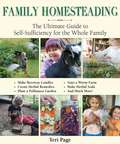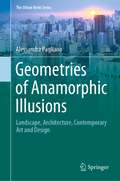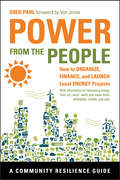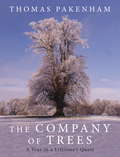- Table View
- List View
Japanese Optical and Geometrical Art (Dover Pictorial Archive)
by Hajime OuchiSome of the most ingenious and attractive modern motifs. 746 designs.
Gardens of the High Line: Elevating the Nature of Modern Landscapes
by Piet Oudolf Rick DarkeThe Gardens of the High Line is the first book devoted to the plants and planting design of New York City's iconic High Line. In its sumptuous pages, Piet Oudolf, who designed the original plantings, and Rick Darke, a leading voice in sustainable horticulture, reveal why the High Line is such an iconic example of landscape design.
Planting the Natural Garden
by Piet Oudolf Henk Gerritsen“If the world of gardening has rock stars, Piet Oudolf qualifies as Mick Jagger, David Bowie, and Prince rolled into one.” —Gardenista The original publication of Planting the Natural Garden ushered in a revolution in landscape design: the New Perennial Movement. Spearheaded by internationally renowned designer Piet Oudolf, and incisively articulated by the late plantsman and designer Henk Gerritsen, it transformed private and public spaces with its emotionally resonant, naturalistic use of hardy perennials and grasses. Now this classic has been expanded and updated to include scores of new plants and combinations. Packed with practical information and visual inspiration, Planting the Natural Garden zeroes in on the New Perennial Movement’s power to move us, making its distinctive plant palette available to all. For enthusiasts of these vibrant landscapes, it is an essential text; for gardeners who love the dreamy moods and colors that Oudolf and Gerritsen celebrate, it’s the key to a magic kingdom of garden beauty.
Correction of Differential Settlements in Mexico City's Metropolitan Cathedral and Sagrario Church (Built Heritage and Geotechnics)
by Efraín Ovando-Shelley Enrique SantoyoThis book describes the geotechnical aspects for correcting the geometry of Mexico City´s Metropolitan Cathedral and of the adjoining Sagrario Church. It describes the main aspects of geotechnical conditions in the city and of the most important hazards affecting these monuments. It discusses the analyses performed and the actions taken to achieve the corrections required. The book aims to provide non-specialists with a clear picture of the magnitude and importance of the project and of the achievements it fulfilled. It is expected that the book will also appeal to specialized geotechnical engineers that will be provided with references to follow up the project in depth. The book will contain a large number of illustrations and will be written so as to provide "down to earth" explanations of the basic theories applied and of the actual construction procedures The work will appeal to both students and professionals in the fields of Architecture and Civil Engineering. It will also interest specialized audiences of geotechnical engineers and conservation architects and it may also be of value to art historians.
Sheetrock & Shellac: A Thinking Person's Guide to the Art and Science of Home Improvement
by David OwenIn a world of extreme makeovers, this book is a thoughtful, adventure-filled, witty look at what the space we live in says about us, the pleasures of home renovation projects great and small, and how home renovation can change our lives. Few things define us as powerfully as the place where we live. The size and location of a house may reveal basic facts about our financial or social status, but it is the personal touches -- a paint color or a homemade desk -- that reflect our aspirations, our tastes, our secret desires. In Sheetrock & Shellac, David Owen recounts his renovation and home construction projects in small-town Connecticut -- from catching the home improvement bug while watching workmen replacing a leaky roof to his first tentative foray into DIY (successfully building an enclosure for a bathroom radiator that had "turned into a sort of low-tech factory for converting splattered urine into odor and dust"). As his skill grows, so does his confidence: replacing a broken light switch turns into wiring an entire room, making bookcases is followed by building an office. Some of the more overly imaginative projects -- for instance, an ambition to install sinks and hot and cold faucets in all the rooms of the house -- never come to fruition but are amusingly recounted for other intrepid home designers. Owen's two-hundred-year-old farmhouse provides numerous occasions for home improvement projects, and layers (literally) of fascination. Owen quickly learns the hard way when to tackle a project himself and when to turn for help. But soon he's so comfortable with the undertaking that he decides to take the big leap from renovation to building a completely new home from the ground up. In this case, Owen decides to build a weekend cabin a mere six miles away from his home. From a discourse on kitchen countertop materials to the complete history of concrete, to a near-disastrous mishap with a tree, a newly constructed roof, and an overzealous chainsaw, Owen's journey through home designing and building proves both enthrallingly educating and hilariously detailed. New Yorker writer Owen's engaging narrative, filled with a wealth of practical information, hands-on tips, and canny insights, explores the ways in which the human processes of construction and renovation leave all the parties transformed. More than a simple how-to, Sheetrock & Shellac is a why-to, a wellspring of savvy advice and encouragement for anyone who has ever contemplated changing their surroundings and changing their life.
Self-build: How to design and build your own home
by Julian OwenIf you’ve ever dreamt of designing and building your own home, this book is for you. Becoming a ‘self-builder’ doesn’t necessarily mean learning to build a house physically from scratch. Anyone can be a self-builder – you can do so without ever having to lay a brick yourself. Self-built homes can also be more individual, better designed and more economical than buying from a developer. This book is designed for homeowners and self-builders, whether aspiring or on the brink of starting a project. It provides a jargon-free, step-by-step guide to the process of designing and building your own home, distilling all of the practical information needed to make your dream house a reality. Carefully crafted to offer friendly, easy-to-understand practical guidance and packed with watch points, hints and tips, it also highlights the potential pitfalls and suggests ways of avoiding them. Including indications of costs and timescales, Self-build demystifies the process of budgeting, finding a site, gaining planning permission, designing your home and all of the surrounding issues to do with sustainability, planning, regulations, procurement and the use of building contracts. Beautifully illustrated with over 230-colour photos, diagrams and plans, it provides all the inspiration and ideas you need to bring your own project to life. Featured houses include: Amphibious House by Baca Architects Corten Courtyard House by Barefoot Architects Haringey Brick House by Satish Jassal Architects Shawm House by Mawson Kerr Architects Sussex House by Wilkinson King Architects The Pocket House by Tikari Works Architects.
Grow the Good Life: Why a Vegetable Garden Will Make You Happy, Healthy, Wealthy, and Wise
by Michele OwensA lively, passionate argument for the backyard vegetable garden, drawing on science, history, and stories from the author's garden.Our parents saw supermarkets and processed foods as the height of convenience. But nothing is more convenient than grocery shopping in the backyard. A vegetable garden offers the best defense against rising food prices, the most environmentally sound way to eat, and better exercise than any gym. It will turn anyone into a wonderful cook, since nothing tastes more vibrant than homegrown. And it can take less time every week than a trip to the supermarket.In Grow the Good Life, Michele Owens, an amateur gardener for almost two decades, makes an entertaining and persuasive case for vegetable gardens. She starts with two simple but radical ideas: Growing food on a small scale is easy, and it is absurdly rewarding.With her wry, funny, and accessible approach, Owens helps beginning gardeners overcome obstacles that keep them from planting a few seedlings every spring. She explains why dirt isn't dirty; the health benefits of growing one's own food; and that vegetable gardens are not antithetical to the frantic pace of modern life, but simple and undemanding if intelligently managed.Grow the Good Life is not just another how-to. Instead, it will teach you the true fundamentals of vegetable growing: how to fit a garden into your life and why it's worth the trouble.
Organized Simplicity: The Clutter-Free Approach to Intentional Living
by Tsh OxenreiderOrganized Simplicity's aim is to convince its readers that simple living is the absolute best way to live. Be it with house cleaning, family schedule management, personal finances, and managing the "stuff" you allow within your four walls, the only way to live well is to do so intentionally and simply. The first half of the book delves into the "why" behind realistic simple living, giving the reader a nail to then hang the how of living simply discussed in the second half. And by redefining the too often-used phrase "simple living," a busy home manager living in the real world can then make practical changes that work for the whole family. There are chapters for cleaning and organizing the home room-by-room, and future project ideas will inspire readers to turn their house in a haven they love.
Housing Policy and Rented Housing in Europe
by Michael Oxley Jaqueline SmithThe book will inform a wide audience about the provision of rented housing in several European countries. The material is relevant to many housing, surveying and planning undergraduate and postgraduate courses which have a European housing element/option.
Survey and Repair of Traditional Buildings
by Richard OxleyUnderstanding the unique requirements of traditional buildings is crucial to providing appropriate guidance on their care and repair. This book will help practitioners identify the particular issues relating to older buildings and the problems they may encounter when surveying and repairing them. With the use of examples, the author provides invaluable information on how traditional buildings perform, emphasizing the need for a sensitive and sustainable approach which also takes account of the specific needs of the building. The book examines all aspects to be included in any assessment for survey and repair, and points out in detail the potential pitfalls. It also explores the controversial issues surrounding the treatment of damp and timber decay, advocating solutions that are appropriate to older buildings rather than using standard, often damaging, methods of treatment. The extensive case studies not only illustrate good conservation in practice but also how projects can go badly wrong, and how mistakes could have been avoided. This title explores the causes of movement and the actions required. It advises on alternatives to chemical treatment for damp and timber decay. It provides fully illustrated case studies with numerous photographs. It emphasizes a sustainable approach to conservation. It outlines the key legislation issues. It includes the Historic Buildings Prosecution Fines Database and other useful appendices.
Relish
by Daphne OzOz--a co-host on the hit daytime talk show "The Chew," bestselling author of "The Dorm Room Diet," and Dr. Mehmet Oz's daughter--offers simple, practical advice on living the best life right now.
Urban Renewal and School Reform in Baltimore: Rethinking the 21st Century Public School
by Erkin ÖzayUrban Renewal and School Reform in Baltimore examines the role of the contemporary public school as an instrument of urban design. The central case study in this book, Henderson-Hopkins, is a PK-8 campus serving as the civic centerpiece of the East Baltimore Development Initiative. This study reflects on the persistent notions of urban renewal and their effectiveness for addressing the needs of disadvantaged neighborhoods and vulnerable communities. Situating the master plan and school project in the history and contemporary landscape of urban development and education debates, this book provides a detailed account of how Henderson-Hopkins sought to address several reformist objectives, such as improvement of the urban context, pedagogic outcomes, and holistic well-being of students. Bridging facets of urban design, development, and education policy, this book contributes to an expanded agenda for understanding the spatial implications of school-led redevelopment and school reform.
Architectural Interior Lighting
by Gurkan OzenenArchitectural Interior Lighting is an essential guide to creating well-lit, visually appealing interior spaces. The book begins with an overview of light and color theory, lighting fundamentals, and design principles. It then covers artificial, natural, decorative, and professional lighting in interior design, as well as standards and regulations, controls and systems, sustainable lighting, energy efficiency, light pollution reduction, and the use of environmentally friendly materials. With a focus on practical applications and real-world examples, this book provides readers with the tools and knowledge necessary to achieve their design goals while considering the latest trends and techniques in the field. A valuable resource for professionals and students in architecture and lighting design, it will also appeal to anyone interested in creating visually stunning and functional interior spaces.
Il tuo giardino in vaso in poche semplici mosse
by Vanessa P. Meg SmolinskiIl giardinaggio in vaso è divertente, facile ed è un ottimo modo per far crescere dei prodotti freschi quasi tutto l’anno. Questa guida aiuterà sia i principianti sia gli esperti giardinieri ad ottenere il massimo dal tuo giardino in vaso con fantastici trucchi e consigli! In questo libro imparerai: 1. A comprendere il concetto di giardinaggio in vaso e come questo sia il modo migliore per le persone in tutto il mondo per iniziare a fare del giardinaggio – anche per coloro che vivono in appartamento in un condominio! 2. A scegliere il giusto tipo di contenitori per il tuo giardino in vaso 3. Dei consigli per evitare che le tue piante muoiano! 4. La manutenzione adatta a un giardino urbano 5. I segreti su come mantenere bello e prosperoso il tuo giardino in vaso Inizia oggi a lavorare al tuo giardino in vaso e fai crescere dei bei fiori, ortaggi e della bella frutta. Acquista questa guida per creare il tuo giardino in modo CORRETTO
Homelessness and the Built Environment: Designing for Unhoused Persons
by Jill Pable Yelena McLane Lauren TrujilloHomelessness and the Built Environment provides a practical introduction to the effective physical design of homes and other facilities that assist unhoused persons in countries identified as middle- to high-income. It considers the supportive role that design can play for unhoused persons and other users and argues that the built environment is an equal partner alongside other therapies and programs for ending a person’s state of homelessness. By exploring issues, trends, and the unique potential of built environments, this book moves the needle of what is possible to assist people experiencing trauma. Examining important architectural and interior architectural design considerations in detail within emergency shelters, transitional shelters, permanent supportive housing, day centers, and multi-service complexes such as space planning choices, circulation and wayfinding, visibility, lighting, and materials and finishes, it provides readers with both curated conclusions from empirical knowledge and experienced designers’ perspectives. Homelessness and the Built Environment is an imperative and singular reference for interior designers, architects and building renovation sponsors, design researchers and students forging new discoveries, and policy makers who seek to assist communities affected by homelessness.
Felt It!: 20 Fun & Fabulous Projects to Knit & Felt
by Maggie PaceCrafter Maggie Pace converts avid knitters of all kinds into industrious, smiling felters in this fun, easygoing guide to the simplest of fiber crafts. Pace guides you through 20 fabulous knittable accessory projects and shows you how to transform them with a quick trip through the washing machine. From hats and bags to scarves and sew-on embellishments, this simple method produces soft felt every time, and is versatile enough to work with any knit-worthy piece you can dream up.
Hybrid Modernity: The Public Park in Late 20th Century China (Ashgate Studies in Architecture)
by Mary G. PaduaThis book provides a detailed historical and design analysis of the development of parks and modern landscape architecture in late 20th century China. It questions whether the fusion of international influences with the local Chinese design vocabulary in late 20th century China has created a distinctive and novel approach to the design of public parks. Hybrid Modernity proposes a new theory for examining the design of public parks built in post-Mao China since the reforms and sets the various processes for China’s late 20th century socio-cultural context. Drawing on modernization theory, research on China’s modernity, local and global cultural trends, it illustrates through a range of case studies ways hybrid modernity defines a new design genre and language for the spatial forms of parks that emerged in China’s secondary cities. Featured case studies include the Living Water Park in Chengdu, Sichuan province, Zhongshan Shipyard Park in Guangdong Province, Jinji Lake Landscape Master Plan in Suzhou, Jiangsu province, and the West Lake Southern Scenic Area Master Plan in Hangzhou, Zhejiang province. This book argues that these forms represent a new stage in China’s history of landscape architecture. The work reveals that as a new profession, landscape architecture has greatly contributed to China’s massive urban experiment. This book is an ideal read for students enrolled in landscape architecture, architecture, fine arts and urban planning programs who are engaged in learning the arts and international design education.
Women and the Collaborative Art of Gardens: From Antiquity to the Present (Routledge Environmental Literature, Culture and Media)
by Victoria E. Pagán Judith W. PageWomen and the Collaborative Art of Gardens explores the garden and its agency in the history of the built and natural environments, as evidenced in landscape architecture, literature, art, archaeology, history, photography, and film. Throughout the book, each chapter centers the act of collaboration, from garden clubs of the early twentieth century as powerful models of women’s leadership, to the more intimate partnerships between family members, to the delicate relationship between artist and subject. Women emerge in every chapter, whether as gardeners, designers, owners, writers, illustrators, photographers, filmmakers, or subjects, but the contributors to this dynamic collection unseat common assumptions about the role of women in gardens to make manifest the significant ways in which women write themselves into the accounts of garden design, practice, and history. The book reveals the power of gardens to shape human existence, even as humans shape gardens and their representations in a variety of media, including brilliantly illuminated manuscripts, intricately carved architectural spaces, wall paintings, black and white photographs, and wood cuts. Ultimately, the volume reveals that gardens are best apprehended when understood as products of collaboration. The book will be of interest to scholars and students of gardens and culture, ancient Rome, art history, British literature, medieval France, film studies, women’s studies, photography, African American Studies, and landscape architecture.
Grow the Best Tomatoes: Storey's Country Wisdom Bulletin A-189 (Storey Country Wisdom Bulletin Ser.)
by John PageSince 1973, Storey's Country Wisdom Bulletins have offered practical, hands-on instructions designed to help readers master dozens of country living skills quickly and easily. There are now more than 170 titles in this series, and their remarkable popularity reflects the common desire of country and city dwellers alike to cultivate personal independence in everyday life.
Reconsidering Jane Jacobs
by Max Page Timothy MennelThis volume begins with the premise that the deepest respect is shown through honest critique. One of the greatest problems in understanding the influence of the author on cities and planning is that she has for much of the past five decades been "Saint Jane, the housewife" who upended urban renewal and gave us back our cities. Over time, she has become a saintly stick figure, a font of simple wisdom for urban health that allows many to recite her ideas and few to understand their complexity. The author has been the victim of her own success. This book gives this important thinker the respect she deserves, reminding planning professionals of the full range and complexity of her ideas and offering thoughtful critiques on the unintended consequences of her ideas on cities and planning today. It also looks at the international relevance – or lack thereof – of her work, with essays on urbanism in Abu Dhabi, Argentina, China, the Netherlands, and elsewhere.
Family Homesteading: The Ultimate Guide to Self-Sufficiency for the Whole Family
by Teri PagePractical advice and hands-on projects for the self-sufficient family In an increasingly digital world, families are looking for ways to deepen their connection to one another and to the land. The Family Homestead is a guide to a simpler life, one that integrates children into the daily work of creating a sustainable homestead. From gardening and cooking, to herbalism and natural crafts, The Family Homestead shares stories and hands-on projects that will deepen relationships and build self-sufficiency skills. Teri Page, author of the popular Homestead Honey blog, moved with her husband across country with young children to build their off-the-grid homestead on raw land. Together, they garden, forage, preserve foods, raise chickens, homeschool, and so much more. Perfect for homeschooling families or anyone working with or raising kids, readers will learn how to involve children in dozens of homesteading projects. Learn how to: Dye cloth with plant-based dyesMake beeswax candles Construct a rain barrel Hatch chicks Create a worm farm Grow giant pumpkins Make butter in a mason jar Make homemade herbal soda And so much more!
Geometries of Anamorphic Illusions: Landscape, Architecture, Contemporary Art and Design (The Urban Book Series)
by Alessandra PaglianoThis book intends to focus exclusively on anamorphic experiments in contemporary art and design, leaving an in-depth historical examination of its Baroque season to other studies. Themes, languages and fields of application of anamorphosis in contemporary culture are critically analyzed to make the reader aware of the communicative potentiality of this kind of geometrical technique. The book also has the aim to teach the reader the most appropriate geometric techniques for each of them, in order to achieve the designed illusion. Each typology of anamorphosis is accompanied in this book by contemporary installations, a geometrical explanation by means of 3D models and didactic experiments carried on in collaboration with the students of the Department of Architecture in Naples.
Power from the People: How to Organize, Finance, and Launch Local Energy Projects
by Greg Pahl"Over 90 percent of US power generation comes from large, centralized, highly polluting, nonrenewable sources of energy. It is delivered through long, brittle transmission lines, and then is squandered through inefficiency and waste. But it doesn't have to be that way. Communities can indeed produce their own local, renewable energy. Power from the People explores how homeowners, co-ops, nonprofit institutions, governments, and businesses are putting power in the hands of local communities through distributed energy programs and energy-efficiency measures. Using examples from around the nation - and occasionally from around the world - Greg Pahl explains how to plan, organize, finance, and launch community-scale energy projects that harvest energy from sun, wind, water, and earth. He also explains why community power is a necessary step on the path to energy security and community resilience - particularly as we face peak oil, cope with climate change, and address the need to transition to a more sustainable future. This book - the second in the Chelsea Green Publishing Company and Post Carbon Institute's Community Resilience Series - also profiles numerous communitywide initiatives that can be replicated elsewhere. "--
The Company of Trees: A Year in a Lifetime's Quest
by Thomas Pakenham'The master. Puts all other modern tree-writers in the shade' John Lewis-Stempel, author of MeadowlandThomas Pakenham is an indefatigable champion of trees. In The Company of Trees he recounts his personal quest to establish a large arboretum on the family estate, Tullynally in Ireland; his forays to other tree-filled parks and plantations; his often hazardous seed-hunting expeditions; and his efforts to preserve magnificent old trees and historic woodlands.Whether writing about the terrible storms breaking the backs of hundred-year-old trees or a fire in the peat bog on Tullynally which threatens to spread to the main commercial spruce-woods, his fear of climate change and disease, or the sturdy young saplings giving him hope for the future, his book is never less than enthralling.
